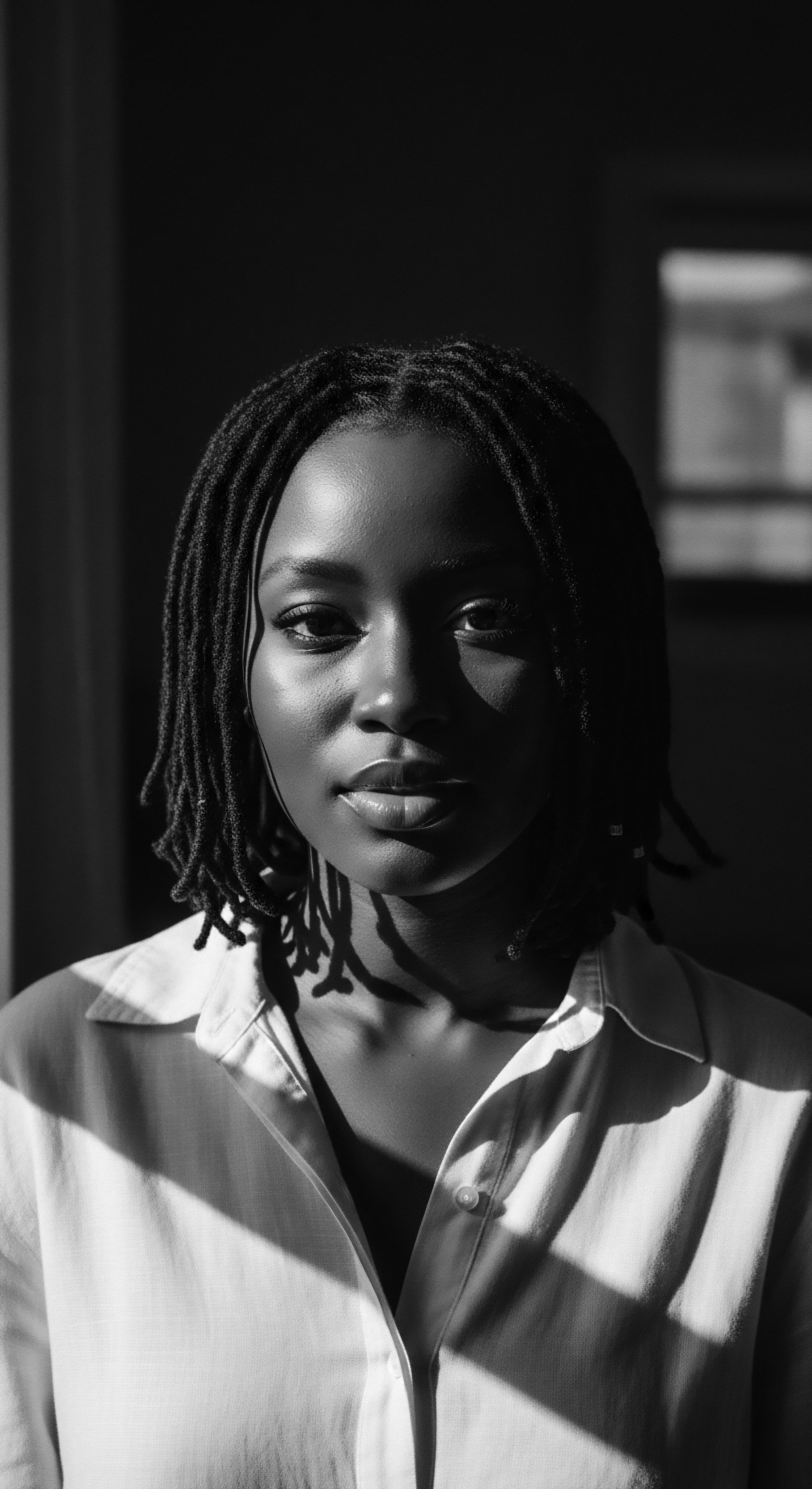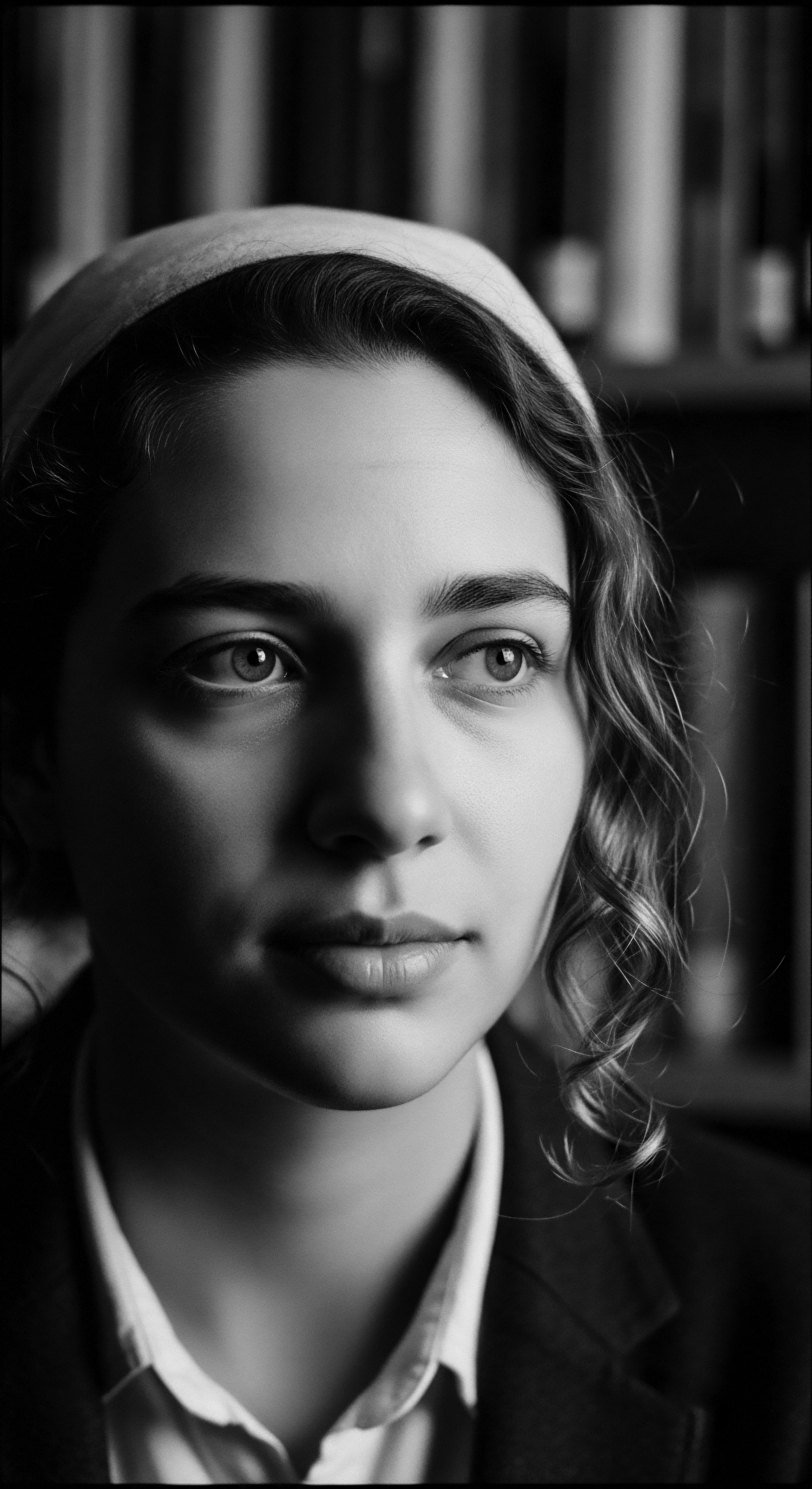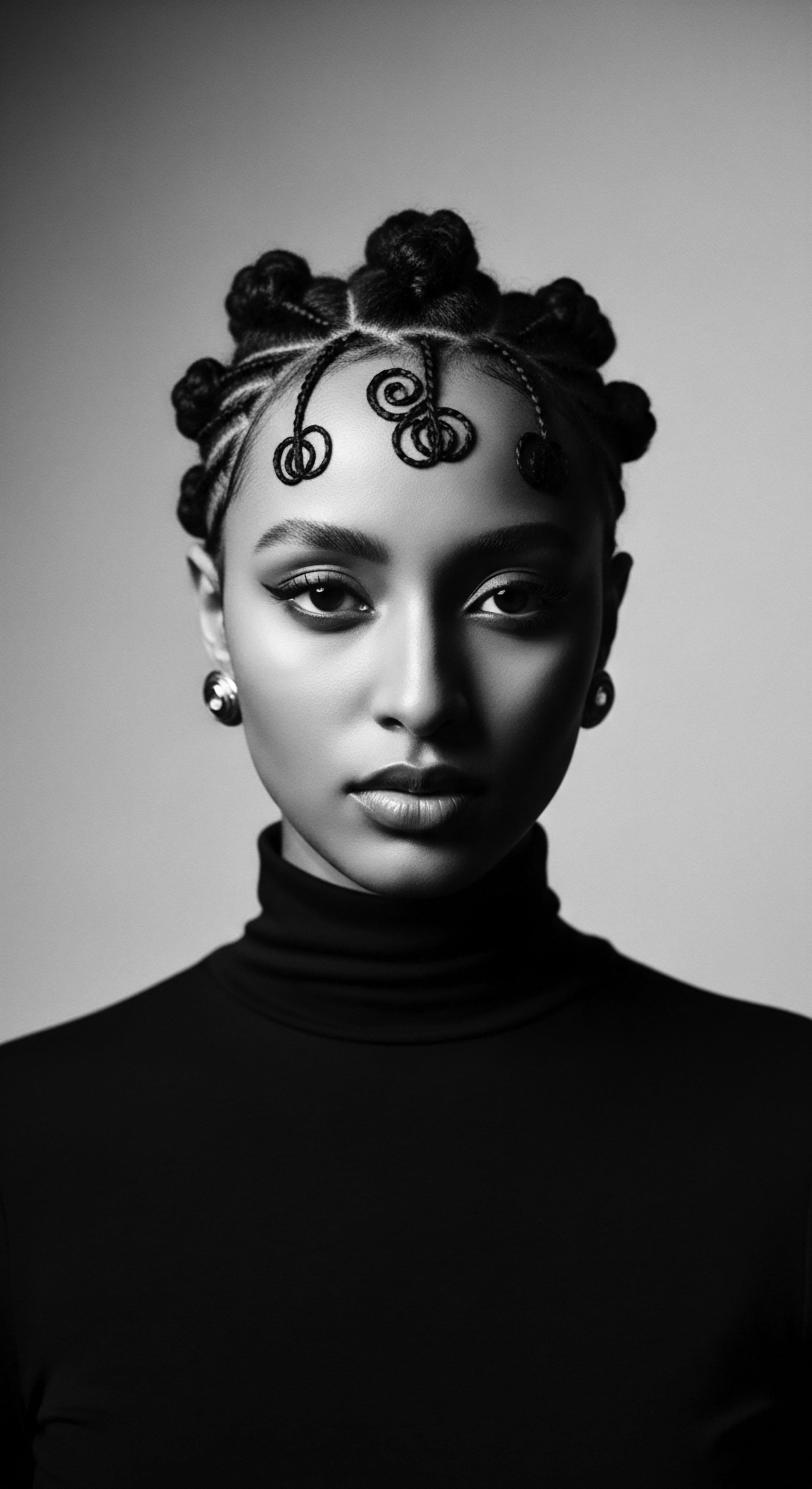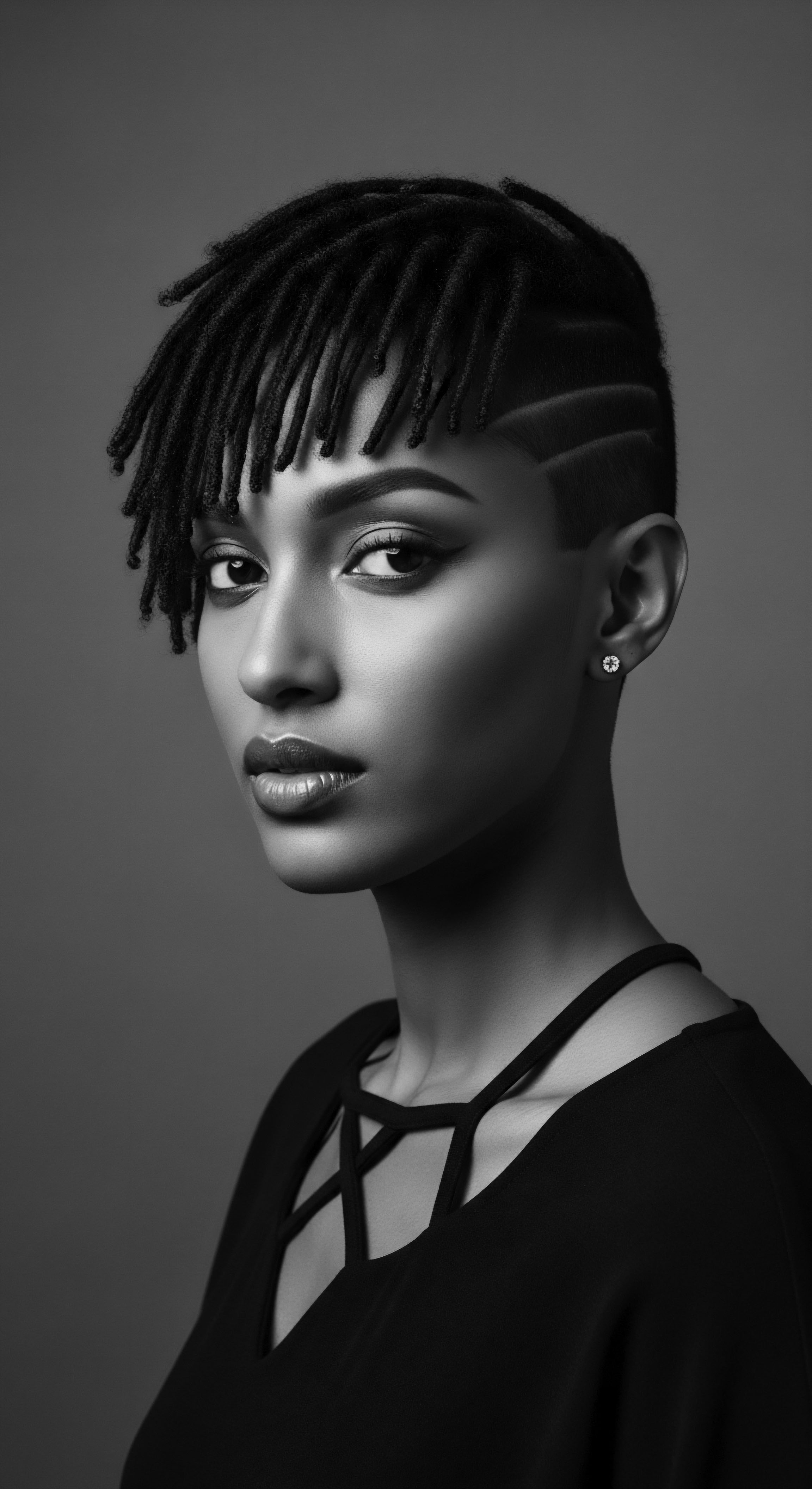
Fundamentals
The Head Covering Practices, within the living library of Roothea, signify a profound ancestral gesture, a silent declaration of identity, protection, and reverence for the crowning glory of textured hair. This practice extends far beyond mere adornment; it is a fundamental aspect of holistic hair care and cultural expression, deeply interwoven with the heritage of Black and mixed-race communities across the globe. At its simplest, a head covering serves as a physical barrier, shielding the hair from environmental aggressors, preserving moisture, and maintaining intricate styles. Yet, its meaning transcends the purely practical, embodying layers of cultural memory and spiritual significance.
Consider the elemental role of a covering ❉ it guards the delicate strands, particularly those with intricate curl patterns and unique porosities characteristic of textured hair, against the harsh realities of sun, wind, and dust. For generations, ancestral wisdom understood that exposure could compromise hair health, leading to dryness, breakage, and loss of vitality. A simple cloth, carefully draped or intricately tied, became a protective cocoon, allowing the hair to retain its natural oils and strength. This fundamental act of safeguarding speaks to a deep, intuitive understanding of hair biology long before the advent of modern science.
The earliest iterations of head coverings were likely born of necessity, a pragmatic response to climate and daily labor. In sun-drenched landscapes, a wrap offered solace from scorching rays, preventing sun damage to the scalp and hair. During arduous tasks, it kept hair clean and contained. Over time, these practical garments began to absorb deeper meanings, becoming canvases for cultural artistry and markers of social standing.
The choice of fabric, the tying technique, and the accompanying adornments all contributed to a complex visual language understood within the community. This initial utility gradually evolved into a rich cultural practice, preserving not only hair but also a heritage of ingenuity and adaptation.
A head covering acts as a timeless shield for textured hair, preserving its inherent moisture and protecting it from the elements, a practice rooted in ancestral wisdom.

Early Protective Gestures
Across diverse ancestral landscapes, the impulse to safeguard the hair found tangible expression through various coverings. From the woven grasses of ancient African civilizations to the meticulously folded textiles of Caribbean forebears, each material offered a distinct form of defense. These initial protective gestures were not random; they were deliberate acts of care, reflecting a profound respect for the hair’s inherent beauty and vulnerability. The understanding that hair, particularly kinky, coily, and curly textures, required specific protection from friction, dryness, and environmental stress was an unspoken truth passed down through generations.
- Shemagh ❉ In parts of North Africa and the Middle East, the shemagh, a traditional scarf, provided protection from sun and sand, allowing the hair beneath to retain moisture.
- Tignon ❉ In colonial Louisiana, the tignon, a headwrap, was mandated by law for free women of color, yet it was transformed into a symbol of defiance and beauty.
- Gele ❉ Worn across West Africa, the gele is a sophisticated headwrap, often signifying social status, marital status, or celebration, while also protecting intricate hairstyles.

Beyond the Practical ❉ A Budding Language
As societies grew more complex, the practical aspects of head covering began to intertwine with burgeoning cultural expressions. The simple act of wrapping the head began to convey messages ❉ a woman’s marital status, her lineage, her religious devotion, or even her mourning. This burgeoning language, spoken through fabric and form, demonstrates the early recognition of hair and its covering as powerful communicators of identity.
The patterns on the cloth, the vibrant hues, and the manner in which the fabric was folded or knotted became part of a collective understanding, adding layers of significance to an already essential practice. This transition from purely utilitarian to culturally symbolic marked a significant step in the enduring legacy of head coverings.

Intermediate
The Head Covering Practices extend beyond basic protection, representing a sophisticated continuum of cultural identity, spiritual devotion, and an ancestral commitment to the wellbeing of textured hair. This practice embodies a deep understanding of the unique physiological needs of kinky, coily, and curly strands, recognizing their propensity for moisture loss and fragility when exposed. The deliberate act of covering the head becomes a tender ritual, preserving not only the physical integrity of the hair but also the spiritual and communal bonds tied to its care. This layer of meaning moves past mere utility into the realm of cherished tradition and self-definition.
The historical trajectory of head coverings within Black and mixed-race communities is not monolithic; it reflects a diverse array of adaptations, resistances, and celebrations. In many West African societies, for example, headwraps were, and continue to be, elaborate statements of social standing, artistic expression, and spiritual connection. The fabrics chosen—often hand-dyed or intricately woven—carried specific cultural meanings, and the techniques of tying could indicate regional origin or familial lineage.
These coverings were not simply worn; they were sculpted, architectural feats that honored the wearer and their community. This richness of tradition underscores the deep, inherited wisdom embedded within these practices.
Head coverings within textured hair heritage signify a profound interplay of cultural identity, spiritual devotion, and a nuanced understanding of hair’s inherent needs.

Cultural Narratives and Resilience
During periods of enslavement and colonial oppression, head coverings acquired additional layers of meaning, becoming symbols of both subjugation and profound resilience. In some contexts, they were imposed as markers of social distinction, yet within the same breath, enslaved and free Black women transformed these mandates into powerful statements of defiance and self-possession. The forced wearing of headwraps, such as the tignon in Louisiana, intended to humble and erase identity, was met with ingenious creativity. Women would tie their tignons with such artistry and flair that they became objects of admiration, subverting the oppressive intent and asserting an undeniable presence.
This historical example powerfully illuminates the Head Covering Practices’s connection to textured hair heritage and Black hair experiences. Historian Virginia M. Gould, in her work on New Orleans women, details how the tignon, originally a symbol of control, was repurposed by free women of color into a fashion statement that often surpassed the elegance of their white counterparts, effectively reclaiming agency and aesthetic autonomy through their hair and its adornment (Gould, 1996). This act of sartorial rebellion speaks volumes about the enduring spirit and resourcefulness embedded within Black hair traditions.
The headwrap, therefore, became a silent chronicle of survival, a vibrant banner of cultural memory. It served as a protective shroud for hair that was often subjected to harsh conditions and inadequate care, while simultaneously allowing for a subtle yet potent expression of self in environments designed to strip away identity. This dual function—of physical protection and cultural preservation—demonstrates the deep significance of these practices. The head covering became a testament to an unbroken lineage of self-respect and communal pride, a living archive of resistance etched in fabric and form.

Holistic Care and Ancestral Wisdom
Beyond the visible cultural statements, the Head Covering Practices also align with holistic hair wellness principles passed down through generations. For textured hair, prone to dryness and tangling, covering the hair, especially at night, mitigates friction against pillows, reducing breakage and preserving moisture. This practice is often coupled with the application of traditional oils and butters, allowing these nourishing agents to deeply penetrate the hair shaft without being absorbed by bedding. The warmth created by a covering can also aid in the absorption of these treatments, mirroring the principles of modern deep conditioning.
| Historical Period/Context Pre-Colonial African Societies |
| Primary Function & Cultural Significance Protection from elements, spiritual significance, social status indicator, artistic expression. |
| Impact on Textured Hair Health Preservation of moisture, defense against environmental damage, encouragement of growth. |
| Historical Period/Context Transatlantic Enslavement Era |
| Primary Function & Cultural Significance Imposed subjugation, covert resistance, assertion of identity, preservation of cultural memory. |
| Impact on Textured Hair Health Protection from harsh labor conditions, reduction of breakage, concealment of damaged hair. |
| Historical Period/Context Post-Emancipation & Early 20th Century |
| Primary Function & Cultural Significance Symbol of modesty, religious adherence, class distinction, and continued cultural connection. |
| Impact on Textured Hair Health Maintained cleanliness, protected styled hair, aided in moisture retention. |
| Historical Period/Context Civil Rights Era & Black Power Movement |
| Primary Function & Cultural Significance Political statement, celebration of Black identity, rejection of Eurocentric beauty standards. |
| Impact on Textured Hair Health Affirmed natural hair, protected styles like Afros, minimized need for damaging chemical treatments. |
| Historical Period/Context Contemporary Era (Global Diaspora) |
| Primary Function & Cultural Significance Fashion statement, spiritual observance, hair protection, personal expression, ancestral connection. |
| Impact on Textured Hair Health Nighttime protection (bonnets, wraps), moisture retention, style preservation, reduction of manipulation. |
| Historical Period/Context The journey of head coverings reflects a continuous adaptation and redefinition, always connected to the wellbeing and identity of textured hair across time. |
The tender application of silk or satin bonnets before rest, a widespread practice today, is a contemporary echo of these ancestral insights. These materials minimize friction, which is a significant cause of breakage for delicate textured strands. The underlying wisdom is consistent ❉ protect the hair, nourish it, and allow it to thrive. This gentle wisdom, passed through oral traditions and observed practices, demonstrates a profound understanding of textured hair’s specific needs, a knowledge system that often predates and informs contemporary trichological understanding.

Academic
The Head Covering Practices represent a complex sociocultural phenomenon, an elucidation of human interaction with environment, belief systems, and aesthetic expression, particularly pronounced within communities possessing textured hair. This practice is not merely a superficial custom; it signifies a deeply embedded cultural syntax, a communicative apparatus that articulates identity, status, spirituality, and resistance. From an academic perspective, the delineation of Head Covering Practices requires a multidisciplinary lens, drawing upon anthropology, sociology, material culture studies, and hair science to fully comprehend its pervasive significance. The interpretation of this practice transcends simplistic definitions, instead revealing a layered meaning that has evolved in response to historical exigencies and enduring cultural imperatives.
The historical precedence of head coverings within Black and mixed-race communities offers a compelling case study in cultural resilience and adaptation. The physiological characteristics of textured hair—its unique helical structure, propensity for dryness due to the uneven distribution of sebum, and susceptibility to mechanical damage—rendered protective measures a biological imperative in many climates. Beyond this biological foundation, however, the practice ascended to a profound semiotic level.
In various West African societies, the elaborate tying of headwraps, such as the Gele of Nigeria or the Duku of Ghana, served as non-verbal indicators of a woman’s marital status, economic standing, or ceremonial role. These were not random acts of adornment; they were meticulously crafted expressions of communal belonging and individual distinction, often requiring significant skill and knowledge of traditional textile arts.

The Head Covering as a Site of Contestation and Reclamation
The Transatlantic Slave Trade dramatically altered the context and meaning of Head Covering Practices for Africans in the diaspora. In many colonial contexts, laws were enacted to strip enslaved and free Black individuals of their cultural markers, including their hair and traditional adornments. The Tignon Laws of Louisiana in the late 18th century serve as a poignant example. These decrees mandated that free women of color cover their hair, ostensibly to denote their lower social status and distinguish them from white women.
However, this legislative attempt at social control met with an unexpected counter-response. As historian Virginia M. Gould details in “Chaining Down the Hair ❉ The Tignon Laws and Free Women of Color in Spanish Colonial New Orleans,” the women subjected to these laws transformed the tignon from a symbol of oppression into an artistic statement. They utilized luxurious fabrics—silks, satins, and brocades—and styled their headwraps with such architectural flair and adornment that they became objects of admiration and envy.
This subversive act of aesthetic rebellion transformed a mandated badge of inferiority into a declaration of identity, creativity, and enduring dignity. This specific historical example powerfully illuminates the Head Covering Practices’s connection to textured hair heritage, Black/mixed hair experiences, and ancestral practices of resistance. The act of turning an instrument of subjugation into a tool of self-expression provides a profound insight into the human capacity for resilience in the face of systemic dehumanization.
Head covering practices, particularly within the African diaspora, reveal a powerful history of resistance, where imposed mandates were often subverted into vibrant declarations of identity and autonomy.
The enduring legacy of these practices is not merely historical; it continues to shape contemporary Black hair aesthetics and cultural identity. The widespread adoption of satin bonnets, silk scarves, and durags in modern textured hair care routines is a direct lineal descendant of these ancestral protective and expressive practices. This continuity speaks to a collective ancestral memory, where the wisdom of shielding delicate strands and preserving intricate styles persists across generations. The scientific rationale behind these modern applications—reducing friction, preventing moisture loss, and maintaining curl integrity—validates the intuitive knowledge held by ancestors who understood the fundamental needs of textured hair without the aid of trichological laboratories.

Psycho-Social Dimensions and Identity Formation
Beyond the historical and practical, Head Covering Practices also possess significant psycho-social dimensions. For many, the act of covering one’s hair is deeply intertwined with self-perception, community belonging, and spiritual connection. The covering can serve as a personal sanctuary, a private space for reflection and protection from external scrutiny.
In some religious contexts, such as Rastafarianism or certain Islamic traditions, head coverings are outward manifestations of spiritual commitment and adherence to specific codes of modesty and piety. For individuals within these communities, the practice is not merely a cultural artifact; it is a vital component of their spiritual journey and public identity.
The choice to wear a head covering can also be a powerful act of self-affirmation, particularly for those reclaiming ancestral practices or challenging Eurocentric beauty standards. In an academic paper titled “Hair, Headwraps, and Identity ❉ An Exploration of Black Women’s Hair Practices and Cultural Expression,” scholars examine how head coverings contribute to the construction of a positive racial identity and body image among Black women. The practice becomes a conscious rejection of assimilationist pressures and an embrace of an aesthetic rooted in heritage. This conscious decision to cover the hair, whether for protection, style, or spiritual reasons, reinforces a connection to a collective history and provides a tangible link to a legacy of strength and beauty.
The Head Covering Practices, therefore, serve as a multifaceted lens through which to examine the intricate interplay of cultural heritage, personal agency, and the enduring human desire for self-expression. The meaning of this practice is not static; it is a dynamic concept, continually reinterpreted and re-contextualized by successive generations. The elucidation of Head Covering Practices demands an appreciation for its deep roots in biological necessity, its complex evolution through periods of oppression and resistance, and its ongoing role in shaping identity and fostering community within textured hair populations globally. The delineation of this practice reveals not only a historical artifact but a living, breathing tradition, a testament to the resilience and creativity of human spirit.
Consider the nuanced impact of societal pressures on hair presentation and the subsequent role of head coverings. In environments where textured hair was historically devalued or deemed “unprofessional,” head coverings offered a means of conforming while simultaneously preserving one’s natural hair beneath. This duality highlights a coping mechanism, a strategy for survival in hostile environments, yet also a subtle act of defiance.
The covering became a private space where natural hair could exist, protected from judgment and manipulation, until such a time when it could be freely revealed. This complex interplay of public presentation and private preservation is a crucial aspect of understanding the full spectrum of Head Covering Practices within the Black and mixed-race experience.
- Cultural Preservation ❉ Head coverings often serve as a tangible link to ancestral traditions, preserving techniques of tying and adornment that might otherwise be lost.
- Spiritual Observance ❉ For many, covering the head is a sacred act, signifying devotion, humility, or adherence to religious principles.
- Hair Health Maintenance ❉ The practice provides a protective barrier against environmental damage, friction, and moisture loss, crucial for textured hair types.
- Identity Assertion ❉ Head coverings can be a powerful statement of cultural pride, racial identity, and a rejection of Eurocentric beauty standards.
The ongoing academic inquiry into Head Covering Practices frequently intersects with studies on traditional ecological knowledge and ethnomedicine. For instance, the use of specific plant-derived dyes or treatments applied to hair before covering, often found in historical accounts, points to a sophisticated understanding of botanical properties. These practices, once dismissed as superstitious, are increasingly validated by modern scientific analysis that identifies beneficial compounds in these traditional ingredients.
The synergy between the physical act of covering and the application of natural remedies forms a holistic approach to hair care, where protection and nourishment are inextricably linked. This interconnectedness underscores the profound wisdom embedded in ancestral practices, inviting a deeper, more respectful engagement with these enduring traditions.

Reflection on the Heritage of Head Covering Practices
As we close this exploration, the Head Covering Practices stand as a profound meditation on textured hair, its heritage, and its care, truly a living, breathing archive within Roothea’s embrace. From the elemental biology that calls for protection, through the living traditions of care and community, to its role in voicing identity and shaping futures, the journey of the head covering mirrors the journey of textured hair itself ❉ resilient, adaptive, and endlessly expressive. Each carefully chosen fabric, each deliberate wrap, carries the echoes of ancestral whispers, the strength of those who came before, and the vibrant pulse of contemporary self-definition.
It is a legacy woven not just with thread, but with the very soul of a strand, honoring the deep, unbroken lineage of Black and mixed-race hair traditions. The story of head coverings is a testament to how practical needs can blossom into powerful cultural statements, how acts of resistance can become acts of beauty, and how the simplest gestures can hold the deepest truths about who we are and where we come from.

References
- Gould, V. M. (1996). Chaining Down the Hair ❉ The Tignon Laws and Free Women of Color in Spanish Colonial New Orleans. Louisiana State University Press.
- Byrd, A. D. & Tharps, L. D. (2001). Hair Story ❉ Untangling the Roots of Black Hair in America. St. Martin’s Press.
- Mercer, K. (1994). Welcome to the Jungle ❉ New Positions in Cultural Studies. Routledge.
- hooks, b. (1992). Black Looks ❉ Race and Representation. South End Press.
- Akbar, N. (1998). Light from Ancient Africa. Mind Productions & Associates.
- White, S. (2006). Styling Jim Crow ❉ African American Beauty Training and the Meanings of Race in the United States. University of North Carolina Press.
- Sieber, R. (1972). African Textiles and Decorative Arts. The Museum of Modern Art.
